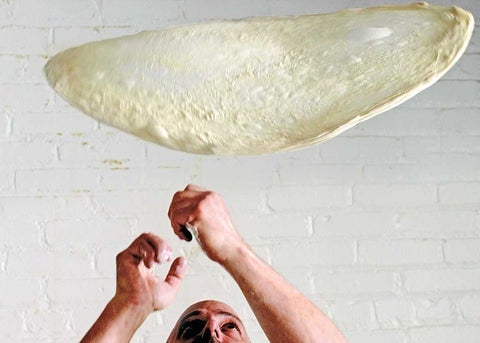How To Make: Pizza Dough
There’s good reason why pizza is the number one take-away food (and it’s not just because it’s delicious). Most people feel uneasy attempting to make pizza crust. And even when they do make homemade pizza, more often than not they’ll buy some pre-made pizza bases or frozen pizza dough, and stick their toppings on that.
But pizza crust need not be difficult or complicated! In fact, it’s one of the easiest things you can make. All pizza dough starts with the same basic ingredients; yeast, flour, water, salt, and olive oil. And whether you prefer thin and crispy pizza crust, or thick and soft, this homemade pizza crust will do the job perfectly – simply roll it out to your desired thickness for an awesome base for your toppings.
Pizza crust requires a lean dough, which means it doesn’t contain eggs or butter. Without this extra fat to make the dough soft, you get a crustier pizza crust (the olive oil keeps the interior on the softer side though, and adds flavour). Here’s exactly what you’ll need.
Yeast
One standard packet of yeast (around 2 and ¼ teaspoons) is all you need, and instant yeast is fine.
Water
Use warm water to cut down on the rise time, but don’t make it too hot – between 100-110°F is the sweet spot (anything over 130°F kills the yeast). 1 and 1/3 cups is the perfect amount.
Flour
Use unbleached organic all-purpose white flour (bleaching strips away some of the flour’s protein, which will affect how much water it can absorb). For a chewier crust, you can use bread flour instead, but add a couple extra tablespoons of water; bread flour contains more protein than all-purpose.
Olive Oil
A couple of tablespoons of extra virgin olive oil adds a wonderful flavor to the dough, and don’t forget to brush it with oil before adding the toppings, which prevents the crust from tasting soggy.
Sugar
An optional extra, some home chefs swear by adding a little sugar - 1 tablespoon increases the yeast’s activity and tenderizes the dough, especially when paired with a little olive oil.
Salt
A pinch or two to taste. Table salt is fine.
Method
Mix all the ingredients together thoroughly in a large bowl. The dough will need “kneading” – this can be done by hand, or with a hand-held or stand mixer, and there are many online video tutorials to help you get the technique right. Once done, place the dough into a pre-greased mixing bowl, cover tightly, and set aside to rise for about 90 minutes, or preferably overnight in the refrigerator. Once you’re ready to make pizza, punch down on the risen dough to release any air bubbles, then divide the dough in two.

That process you see the pros do, when they throw the dough up in the air and toss it around in their hands, is called stretching. If you want to have a go, here’s a handy video tutorial – but it’s not necessary. If it seems a little advanced, simply roll the dough out into a 12-inch circle, aiming for a thickness of about ½ an inch (it can be made a little thinner or thicker as desired). Cover and rest, then lightly brush with some olive oil before adding your toppings. Bake the pizza at a very high temperature – 450°F to 500°F (250°C to 260°C) – for about 15 minutes, then enjoy!
This method yields enough dough for two 12-inch pizzas, but after the dough has risen, you can freeze it. Just lightly coat all sides of the dough ball with nonstick spray or olive oil, put it in a zipped-top bag, and seal tightly, squeezing out all the air. They’ll keep for for up to 3 months – to thaw simply put the frozen dough in the refrigerator for about 8 hours or overnight.
We’ve got all the necessary ingredients for homemade pizza, so why not have a go this weekend? It’s immensely satisfying to make, and fun too – especially if you have kids.

